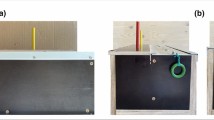Abstract
This study addressed the question: Can novel social behavior arise even though the organism has had no explicit training in that particular social pattern? Seven pigeons were trained individually to peck keys for brief access to food. Four of these birds were also trained to peck two “switching keys” which, at first, raised or lowered the requirements on their own food keys. Later, these switching keys no longer affected an animal’s own requirements, but raised or lowered the requirements imposed on a second pigeon working concurrently for food in an adjacent chamber. The second animal was trained only on the food key. In each such pair, the pigeon trained on the switching keys reliably pecked whichever one raised its partner’s schedule-requirements. This novel pattern of behavior did not directly benefit the first bird, arose spontaneously as a recombination of previously established nonsocial repertoires, and seemed to be maintained entirely by its effects on the animal in the adjacent chamber.
Similar content being viewed by others
References
Andronis, P. T. (1983). Symbolic aggression by pigeons: Contingency coadduction. Dissertation: The University of Chicago, Chicago, IL (UMI Dissertation Services).
Andronis, P. T. (1991). Rule-governance: Enough to make a term mean. In L. J. Hayes & P. N. Chase (Eds.), Dialogues on verbal behavior (pp. 226–235). Reno, NV: Context Press.
Cherek, D. R., & Heistad, G. T. (1971). Fixed-interval-induced aggression. Psychonomic Science, 25, 7–8.
Cherek, D. R., Thompson, T., & Heistad, G. T. (1973). Responding maintained by the opportunity to attack during an interval food reinforcement schedule. Journal of the Experimental Analysis of Behavior, 19, 113–124.
Chomsky, N. (1980a). Initial states and steady states. In M. Piatelli-Palmerini (Ed.), Language and learning: The debate between Jean Peaget and Noam Chomsky (pp. 107–130). Cambridge, MA: Harvard University Press.
Chomsky, N. (1980b). Rules and representations. Behavioral and Brain Sciences, 3, 1–61.
Cole, J. M, & Parker, B. K. (1971). Schedule-induced aggression: Access to an attackable target bird as a positive reinforcer. Psychonomic Science, 22, 33–35.
Donahoe, J., & Palmer, D. C. (1994). Learning and complex behavior, New York: Allyn & Bacon.
Dove, D. L., Rashotte, M. E., & Katz, H. N. (1974). Development and maintenance of attack in pigeons during variable interval reinforcement of keypecking. Journal of the Experimental Analysis of Behavior, 21, 563–569.
Epstein, R. (1981). On pigeons and people: A preliminary look at the Columban Simulation Project. The Behavior Analyst, 4, 43–56.
Epstein, R. (1983). Resurgence of a previously reinforced behavior during extinction. Behaviour Analysis Letters, 3, 391–397.
Epstein, R. (1985). Extinction induced resurgence: Preliminary investigations and possible applications. Psychological Record, 35, 143–153.
Epstein, R. (1987). The spontaneous interconnection of four repertoires of behavior in a pigeon (Columba livia). Journal of Comparative Psychology, 101, 197–201.
Epstein, R., Kirschnit, C. E., Lanza, R. P., & Rubin, L. C. (1984). “Insight” in the pigeon: Antecedents and determinants of an intelligent performance. Nature, 308, 61–62.
Epstein, R., & Skinner, B. F. (1980). Resurgence of responding after the cessation of response-independent reinforcement. Proceedings of the National Academy of Sciences, USA, 77, 6251–6253.
Falk, J. L. (1971). The nature and determinants of adjunctive behavior. Physiology & Behavior, 6, 577–588.
Falk, J. L. (1977). The origins and function of adjunctive behavior. Animal Learning and Behavior, 5, 325–335.
Flory, R. K., & Ellis, B. B. (1973). Schedule-induced aggression against a slide-image target. Bulletin of the Psychonomic Societyre and determinants of adjunct, 2, 287–290.
Frederiksen, L. W., & Peterson, G. L. (1977). Schedule-induced aggression in humans and animals: A comparative parametric review. Aggressive Behaviorre and determinants of adjunct, 3, 57–75.
Geli-Mann, M. (1994). The quark and the jaguar, New York: W. H. Freeman & Co.
Goldiamond, I. (1974). Toward a constructional approach to social problems: Ethical and constitu-tional issues raised by applied behavior analysis. Behaviorismre and determinants of adjunct, 2, 1–84.
Goldiamond, I. (1978). The professional as double-agent. Journal of Applied Behavior Analysisre and determinants of adjunct1, 1, 178–184.
Goldiamond, I. (1984). Training parents and ethicists in nonlinear behavior analysis. In R. F. Dangel & R. A. Polster (Eds.), Parent training: Foundations of research and practice (pp. 504–546). New York, Guilford Press.
Hutchinson, R. R., Azrin, N. H., & Hunt, G. M. (1968). Attack produced by intermittent reinforcement of a concurrent operant. Journal of the Experimental Analysis of Behaviorre and determinants of adjunct, 11, 489–496.
Johnson, K. R., & Layng, T. V. (1992). Breaking the structuralist barrier: Literacy and numeracy with fluency. American Psychologistre and determinants of adjunct, 47, 1475–1490.
Layng, T. V. J. (1991). A selectionist approach to verbal behavior: Sources of variation. In L. J. Hayes & P. N. Chase (Eds.), Dialogues on verbal behavior (pp. 146–150). Reno, NV: Context Press.
Layng, T. V. J. (1994). Programed head-banging by pigeons: Cessation and return. Dissertation: The University of Chicago, Chicago, IL (UMI Dissertation Services).
Layng, T. V. J., & Andronis, P. T. (1984). Toward a functional approach to delusional speech and hallucinatory behavior. The Behavior Analystre and determinants of adjunct, 7, 139–156.
Knutson, J. F. (1973). Aggression as a manipulable behavior. In J. F. Knutson (Ed.), The control of aggression: implications from basic research. Chicago: Aldine Publishing Co.
Looney, T. A., & Cohen, P. S. (1982). Aggression induced by intermittent positive reinforcement. Biobehavioral Reviews, 6, 15–37.
Looney, T. A., & Cohen, P. S., & Yoburn, B. C. (1976). Variables affecting the establishment of schedule-induced attack on pictorial targets in White King pigeons. Journal of the Experimental Analysis of Behaviorre and determinants of adjunct, 26, 349–360.
Lorenz, K. (1967). Evolution and the modification of behavior. Chicago, IL: The University of Chicago Press, First Phoenix Edition.
Lorenz, K. (1981). The foundations of ethology: Principle discoveries on animal behavior. New York: Simon and Schuster.
Palmer, D. C. (1985). Chomsky’s nativism: A critical review. In P. N. Chase & L. J. Parrott (Eds.), Psychological aspects of language (pp. 44–60). Springfield, IL: Charles C. Thomas, Publisher,.
Roper, T. J. (1981). What is meant by the term, “Schedule-induced,” and how general is schedule-induction? Animal Learning and Behaviorre and determinants of adjunct, 9, 423–430.
Schiller, P. H. (1957). Innate motor action as a basis of learning: Manipulative patterns in the chimpanzee. In C. H. Schiller (Ed.), Instinctive behavior: The development of a modern concept (pp. 264–287). New York: International Universities Press, Inc.
Skinner, B. F. (1957). Verbal behavior. New York: Appleton-Century-Crofts.
Staddon, J. E. R. (1977). Schedule-induced behavior. In W. Honig & J. E. R. Staddon (Eds.), Handbook of operant behavior (pp. 125–152). New York, Appleton-Century-Crofts.
Thompson, T., (1964). Visual reinforcement in fighting cocks. Journal of the Experimental Analysis of Behaviorre and determinants of adjunct, 7, 45–49.
Ulrich, R. E., Dulaney, S., Arnett, M, & Meuller, K. (1973). An experimental analysis of nonhuman and human aggression. In Knutson, J. F. (Ed.), The control of aggression: Implications from basic research. Chicago: Aldine Publishing Co.
Wetherington, C. L. (1982). Is adjunctive behavior a third class of behavior? Neuroscience and Biobehavioral Reviewsre and determinants of adjunct, 6, 329–350.
Author information
Authors and Affiliations
Additional information
The first author conducted these experiments in partial fulfillment of requirements for the Ph.D. in Biopsychology at The University of Chicago. The work was supported in part by the RIBA Fund of the Behavior Analysis Research Laboratory (Department of Psychiatry, The University of Chicago), and by U.S.P.H.S. Physiological Psychology Training Grant #5T32MH14256. Special thanks to Joanne Robbins and Phil Chase for their invaluable editorial help. This article is fondly dedicated to the memory of Prof. Israel Goldiamond, whose guiding hand was present throughout the work described.
Rights and permissions
About this article
Cite this article
Andronis, P.T., Layng, T.V.J. & Goldiamond, I. Contingency Adduction of “Symbolic Aggression” by Pigeons. Analysis Verbal Behav 14, 5–17 (1997). https://doi.org/10.1007/BF03392913
Published:
Issue Date:
DOI: https://doi.org/10.1007/BF03392913




